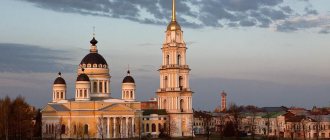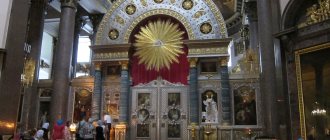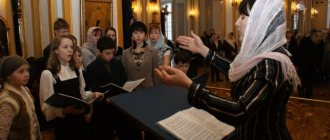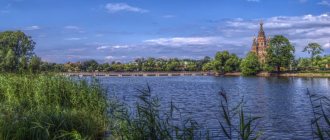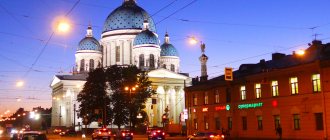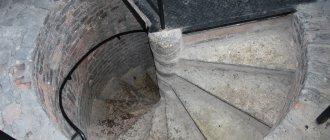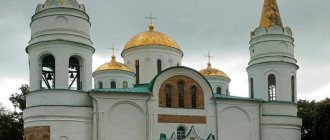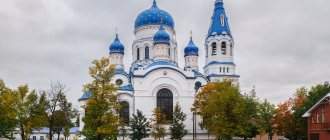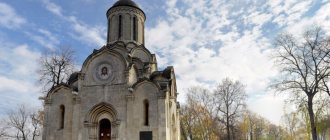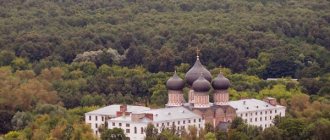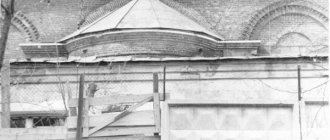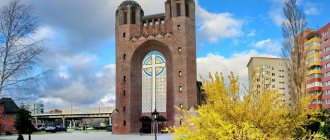The Transfiguration Church is the only St. Petersburg church in which, even during Soviet times and anti-religious propaganda, prayers and services never ceased. Although during this period it was “downgraded” to a parish church, and the valuables stored in it were confiscated (some were transferred to Leningrad museums), believers still had the opportunity to attend services.
The history of the creation of the cathedral is very interesting : it is indirectly related to Peter the Great, who created his “amusing” regiment, which later turned into the Preobrazhensky regiment - it was he who helped Elizabeth Petrovna carry out the coup that led her to the throne. On the site of the headquarters of the grenadier company, a temple was founded in the middle of the 18th century - this is how the empress decided to perpetuate the memory of her rise to power. Later, the cathedral burned down, and many of the shrines kept here were lost. Services began again in the rebuilt church in 1829 .
Did you know?
The architect of the new building received a considerable bonus from the emperor, as well as a ring for his resourcefulness: the cathedral fence was made from the barrels of captured Turkish cannons. This makes the ensemble one of the most original in St. Petersburg. In the pre-revolutionary period, an almshouse, a canteen, an orphanage, and a Temperance Brotherhood were opened at the temple. Fruit markets were held here. During the siege of Leningrad, there was a bomb shelter in the basement that could accommodate up to five hundred people. Today, the Transfiguration Cathedral is one of the most popular churches in St. Petersburg: people visit it to admire the architecture, worship the shrines, and listen to the singing of the choir, of which the soloists of the Academic Chapel .
Spaso-Preobrazhensky Cathedral in St. Petersburg today
In terms of its historical significance, the temple is one of the most important in the city; it is, perhaps, the most sacred place here, prayed for centuries. The cathedral is associated with the spiritual history of Northern Palmyra and with the military successes of the country; it is a federal architectural monument. God's House is a particularly frequently visited shrine in the city on the Neva. It also has another name: “The Cathedral of the Transfiguration of the Lord of the Entire Guard.”
The Transfiguration Cathedral was considered the main church in St. Petersburg for the military; it was called a kind of museum of the glory of the defenders of the Motherland and Russian weapons.
Services in the Cathedral were held constantly, in all years and times, it always received believers. The unified architectural ensemble of the cathedral was conceived and built in such a way that each of its elements carries its own unique semantic and artistic significance.
Clergy personalities associated with the cathedral
On August 6 (18), 1833, on the day of the Transfiguration of the Lord, the Montenegrin ruler and poet Peter II Petrovich Njegosh was ordained bishop in the cathedral.
Since 1881, while serving in the Preobrazhensky Regiment, the head of the cathedral was Guard Staff Captain (later Colonel) Leonid Mikhailovich Chichagov - later Metropolitan Seraphim. Being already Metropolitan of Leningrad (appointed on February 23, 1928), he performed his first service in Leningrad in the cathedral on March 18 (the third Sunday of Lent), as well as his last on October 24, 1933.
In February 1931, in the case of illegally sending the regalia of the Preobrazhensky Regiment to Copenhagen and transferring them to Empress Maria Feodorovna, along with other persons, the rector of the cathedral, Archpriest Mikhail Tikhomirov, was shot.
On April 22, 1979, during the Easter service, Metropolitan Seraphim (Nikitin), formerly of Krutitsky and Kolomna, died in the cathedral.
From July 1981 to 1985, the cleric of the cathedral was priest Evgeniy Zhdan (since 2002 - Metropolitan of Nizhny Novgorod and Arzamas).
Rectors of the cathedral
Rectors of the cathedral throughout history Dates Rector January 28, 1752 - March 13, 1758 Archpriest Luka Ivanov March 13, 1758-1781 Archpriest Andrei Mikhailov 1781 - ... Archpriest Simeon Matfiev 1793-1798 Archpriest Lukian Feodotovich Protopopov June 18, 1799-1806 Priest John Ryabinin 1806 - March 1807 Archpriest Alexander Alexandrov March 31, 1808 - January 1, 1816 Archpriest Alexy Alexievich Toropogritsky June 29, 1816 - September 6, 1829 Archpriest Antipa Gavrilovich Gavrilov January 11, 1830 - April 23, 1867 Archpriest Vasily Iakovlevich Sicilinsky May 12, 1867 - October 15, 18 82 Archpriest Mikhail Mikhailovich Spassky (1800— 1884) 1882 - March 29, 1901 [source not specified 266 days] Archpriest Pyotr Alexievich Zinovievsky April 4, 1901 - February 17, 1908 Archpriest Vladimir Feodorovich Krasnopolsky (1841-...) February 19, 1908 - July 30, 1918 Archpriest Sergiy Alekseevich Golubev (18 60—1918) 1918 - ... archpriest Pyotr Vasilyevich Troitsky (1850 - after 1917) 1921 - July 1923 archpriest Mikhail Vladimirovich Tikhomirov July 1923 - September 1924 "bishop" Evgeniy (Belkov) September 25, 1924 - November 25, 1924 "archimandrite" Ilya (Ilia Gustavovich Trolle) 1924 - January 12, 1925 “priest” Mikhail Vasilievsky January 1925 - April 1925 “priest” A. Stroganov 1932 - August 2, 1933 Archpriest Ksenophon Pavlovich Vinogradov (...-1933) August 26, 1933-1935 Archpriest Ioann Vasilyevich Morev 1935 - March 13, 193 6 Archpriest Nikolai Ioannovich Izmailov (... - around 1942) March 1936 - April 1, 1937 Archpriest Pavel Pavlovich Fruktovsky (1878-1954) April 1, 1937 - October 14, 1937 Archpriest Alexander Feodorovich Arkhangelsky October 1937-1940 Archpriest Pavel Pavlovich Fruktovsky (1878-195 4) 1940 - 19 December 1941 Protopresbyter Alexy Grigorievich Abakumov (1869-1941) December 1941 - January 1944 Archpriest Pavel Pavlovich Fruktovsky (1878-1954) January 12, 1944 - November 21, 1945 Archpriest Pavel Petrovich Tarasov (1899-1971) December 10, 1945 - March 4, 1973 Archpriest Sergius Vladimirovich Rumyantsev (1903-1977) February 21, 1973 - May 25, 1977 Archpriest Iakov Iosifovich Ilyich (1931-1981) May 25, 1977 - March 2, 1986 Archpriest Nikolai Mikhailovich Gundyaev (b. 1940) March 2, 1986 - July 1, 1987 Archpriest Pavel Grigorievich Krasnotsvetov (born 1932) June 23, 1987 - August 11, 2014 Archpriest Nikolai Mikhailovich Gundyaev (born 1940) August 11, 2014 - present Archpriest Nikolai Bryndin
History of foundation, construction
Indirectly related to the beginning of the history and construction of the temple is Peter I, who created a battalion intended for military games; later, under the name of Preobrazhensky, it became part of the active army. With the help of this regiment the coup of 1741 was carried out. After the long, protracted era of temporary workers in Russia, great hopes were pinned on the daughter of Peter the Great.
Taking advantage of dissatisfaction with the authorities, 31-year-old Elizabeth called for a mutiny of the grenadiers of the regiment, and without meeting any resistance anywhere, a new ruler ascended the throne. Elizaveta Petrovna was the godmother of the children of many of the 308 servicemen. Grateful for her accession to the throne, she ordered a church to be built for the Preobrazhensky Regiment in 1743.
At first, the Transfiguration Cathedral in St. Petersburg was built according to a design by Zemtsov, and then the work was carried out by the architect Trezzini. The temple was built and five domes were erected, and it was consecrated on the eve of the Apple Day in 1754. The honorary name of the cathedral of the entire guard was given by Paul I in 1796 to the Transfiguration Cathedral.
During renovations, the church burned down almost completely, but the main relics were saved. Since 1825, after a fire, it was completely restored by V.P. Stasov. The newly rebuilt temple was consecrated in 1829. Since then, the cathedral has been preserved in this form to this day.
History of the shrine
First of all, it should be noted that there are temples with the same name in all countries of the world. But what unites them is that they are all consecrated in honor of an Orthodox religious holiday. Its location is where once upon a time there was one of the main parts of the suburbs of St. Petersburg. This shrine is connected not only with the spiritual history of this city, but also with the victories of the country itself. The place where the church is located at one time, by decree of Empress Catherine I, was built up with military barracks, where Paul Preobrazhensky lived.
At that time, the military capital of Russia was St. Petersburg. The cathedral was built by order of the empress herself. The place where the military barracks stood was chosen as the site for its construction. Elizabeth was a devout person and in those difficult times she often offered prayer requests to the Mother of God. After she began to manage the estate and construction work began on the construction of the temple.
The best article for you, go to: Epiphany Cathedral in Yelokhov
This happened in 1743. This year the laying of the first stone took place. The building was designed by famous architects of that time. Elizabeth herself took an active part in the construction. It was her hand that laid the first stone. She also took part in resolving all issues related to the temple. Eleven years later, the construction work was completed and the temple was consecrated by the archbishop in the presence of the empress.
The building stood for almost thirty years, after which there was a fire. It arose due to the carelessness of workers. As a result, a fairly large part of the building was destroyed. But despite what happened, many holy images were saved from the flames, as well as church utensils and the sacristy. After the tragedy happened with Alexander I, the empress gave an order for the urgent restoration of the temple.
After restoration work, the general appearance of the building was not completely preserved. Minor changes have been made to it. Reconstruction work was carried out quite quickly. And after some time, the temple opened its doors to parishioners. After that, it became the most famous Cathedral throughout the northern capital. He has retained his popularity to this day.
It was restored in the Empire style. It is very important to say that after restoration he did not close his doors to parishioners. The square next to it was also named in honor of the Cathedral. In difficult times for the city's population, when there was a blockade, the basement of the temple acted as a bomb shelter.
The shrine premises are spacious. About 3,500 people can fit inside it. It also has a choir and a Sunday school, which can be attended by both adults and children. The church also operates pilgrimage activities.
The best article for you, go to: St. Sophia Cathedral in Kyiv
Architect, exterior decoration, architectural ensemble
The architecture and composition of the building corresponds to late classicism, but Stasov honored the foundations of the original national architecture, the Kremlin Assumption Cathedral served as a model for him. Therefore, the building has a cylindrical upper part, topped with an onion-shaped vault.
The cross rushed 8 meters into the air. 4 smaller domes (of four evangelists) are displayed in the corners, everything is solemn, strict and laconic. The temple building looks majestic, its height is 41.5 meters. On the western side of the cathedral there is a 12-meter portico with 4 majestic columns, here is the main entrance. Outside you can see military attributes in the design.
To save gilding, Stasov invented an unusual mixture of paints that shimmered with the shine of blued metal. This unique recipe from Stasov turned out to be lost. The Transfiguration Cathedral in St. Petersburg is painted in light yellow tones with white accents of magnificent bas-relief work.
On one of the walls of the cathedral there is an icon with a burning lamp - this is the icon of the Transfiguration of the Lord.
The fence, built according to his own design, in memory of the victories of the Russians over the Turks, is unique in its design and construction. It consists of barrels from recovered enemy cannons, which were taken from defeated fortresses. Arranged in groups, on each central of the three there is a double-headed gilded eagle, the gun barrels are all bound with heavy chains, and they are placed with their muzzles down.
These guns with Ottoman symbols will no longer fire. The Emperor presented Stasov with a diamond ring and an award for saving money when creating an unusual fence. In 1886, a small chapel with stained glass windows was added to this environment of the cathedral, in the same style as the temple.
The planned ensemble and design of the temple square evokes true delight. With the new lighting of the cathedral, in the evening light the sparkling gilded decorations of the main gates look elegant and majestic.
Architecture
The cathedral, 41.5 m high, consists of three chapels:
- main
- southern
- northern
The high walls are decorated with bas-reliefs illustrating biblical scenes combined with military themes. Adjacent to the western facade is a twelve-meter portico with columns of the Ionic order.
The main dome is topped with an eight-meter cross. In the southwestern tower of the cathedral there is a bell tower, and in the northwestern tower there are English chimes, installed in 1854.
The architect laid out a park around the temple.
The five-domed cathedral is made in the spirit of classicism, which is complemented by elements of Russian architecture. The cathedral is surrounded by a very unusual fence, made by V. Stasov in 1828 - 1829. in honor of the victory in the Russian-Turkish war.
The elements of this fence are 102 barrels of captured guns, mounted with the muzzle down, in groups of 3 guns, decorated with double-headed eagles and connected by chains. In 1886, a chapel with a small dome and stained glass windows , created by the architect I. B. Slupsky, appeared on the territory of the cathedral.
Interior decoration
The temple has quite rich decoration. The dome of the cathedral with the star of Bethlehem in the center is decorated with paintings in the color of the cloudy sky , as well as images of angels and saints. Under the dome there is a large chandelier with 120 candles.
In the main chapel there is a four-tiered iconostasis decorated with carvings, which in appearance resembles a triumphal arch. Inside the temple you can see a memorial plaque with lists of the names of officers of the Preobrazhensky Regiment who died between 1702 and 1917.
Interior decoration
The four-tiered iconostasis was painted by Shebuev, Ugryumov, Ivanov and other artists based on Stasov’s sketches. It shot up like a triumphal arch with gilded carvings. Elongated openings with a semicircular top highlight the white walls.
Lots of decorative items based on military symbols and themes. There are 8 angels written between the windows. The top is painted like a blue sky with angels and a radiant star in the center.
Architectural features
The temple was built with five domes, although during the time of Peter the Great the construction of single-domed churches following the example of Europe was widespread. The western façade of the temple is decorated with four twelve-meter-high columns, and the walls are decorated with stucco with military paraphernalia.
The main dome of the cathedral, painted in the color of the sky
The crown of the building is the main dome, painted in the color of the sky, and on either side there are 4 bell towers. All of them have the shape of hemispheres, which also became a distinctive feature of the architectural monument.
On one of the towers there is a clock specially brought for this occasion from England.
Did you know that: during the siege of Leningrad, the basement of the church served as a bomb shelter, where the wounded received the necessary medical care.
Shrines and relics
The cathedral’s shrines are the miraculous icon of the Mother of God “Joy of All Who Sorrow” and the icon of the Savior Not Made by Hands, bringing faith and hope to parishioners.
Peter the Great idolized this face all his life. The emperor bowed and prayed before this icon when the city of St. Petersburg was founded. Peter did not part with the icon in battles; the Holy Face was with him and protected him when he was wounded in the Battle of Poltava.
For the cathedral, the beautiful icon of Our Lady of Tikhvin is incredibly valuable; it is all decorated and shimmers with multi-colored precious stones. Believers worship and pray in front of the images.
Don’t miss the most popular article in the section: Optina Pustyn Monastery - how to get there from Moscow, address, where it is located, history and interesting facts.
Internal organization
When the process of restoration of the temple was underway, its interior had to be slightly changed, especially in such parts as the iconostasis and the altar canopy. Until 1918, the temple was a kind of repository for banners and various military awards, which were subsequently given to the Artillery Museum, and after which they began to be stored in the Hermitage.
The four-tiered iconostasis of the main chapel was made according to Stasov’s drawings
The iconostasis of the chapel of the Transfiguration of the Lord consists of four tiers. The white background of the iconostasis is decorated with gold carvings. Looking at the arch of the central dome, you plunge into the sky, where there is a big star.
Please note: for any temple, its spiritual component is important. The special pride of the Transfiguration Church is the Image of the Savior Not Made by Hands along with the icon of the Mother of God “Joy of All Who Sorrow.”
A distinctive feature of the cathedral is the presence of three chapels. In the center there is an altar consecrated in honor of the Transfiguration of the Lord. To the right of it is a chapel named after Sergius of Radonezh, and to the left - in honor of the saints Pope Clement I and Peter of Alexandria.
Social work, everyday life
At the Transfiguration Cathedral in St. Petersburg, the social service is now engaged in charity work and work related to the public. The tasks of this cathedral service are aimed at supporting parishioners and solving certain problems.
Meetings of young people with the ministers of the cathedral are held at the church in order to attract them to the church, to achieve mutual understanding, so that they do not feel constrained and there is no fear of communication or asking questions to the clergy. Meetings take place on Wednesday evenings.
The Holy Scriptures are studied so that the texts of the Testament are correctly understood.
A competition is being held for readers. With the blessing of the rector, the children's choir actively attracts children.
Shrines[edit]
Near the northern wall of the cathedral, in the left aisle there is a fold with images of the Transfiguration of the Lord, the Great Martyr Panteleimon and the Holy King Constantine. This warehouse was presented to the regimental hospital in 1900 by the then regiment commander, Major General Grand Duke Konstantin Konstantinovich. On the analogue near the right choir in the Transfiguration Cathedral there is an image of the Savior Not Made by Hands, transferred here in 1938 from the Trinity Church on Stremyannaya Street. This icon was painted by the famous Moscow icon painter S. F. Ushakov for Tsar Alexei Mikhailovich and was the favorite image of Peter I. He was with him at the foundation of St. Petersburg, and at the Battle of Poltava, and at his death and funeral service. On the lectern near the left choir lies another revered icon of the Mother of God “Joy of All Who Sorrow.” This is a copy of the miraculous icon from the Moscow Church of the Transfiguration of the Lord on Bolshaya Ordynka, made in 1711 by order of the sister of Peter I, Princess Natalya Alekseevna, in memory of the salvation of the Russian army during the Prut campaign. It was moved to the Transfiguration Cathedral in 1932 from the closed Church of the Resurrection of Christ on Shpalernaya Street.
The Spaso-Preobrazhensky Cathedral housed regimental relics and military trophies, and on the walls were bronze plaques with the names of officers of the Preobrazhensky Regiment who died in battle. The Preobrazhensky uniforms of Alexander I, Nicholas I and Alexander II were kept behind glass in special cabinets, as well as a saber that was with Alexander II during the assassination attempt on March 1 (13), 1881 and retained traces of his blood.
Patronal holidays
The most important events in the life of Jesus Christ and the Mother of God are remembered at Orthodox holidays.
Solemn services take place on the holidays of the Nativity of Christ and Easter, the Annunciation of the Blessed Virgin Mary, the Transfiguration of the Lord and some others.
Official site
The temple has its own website https://spaso-preobr-sobor.ru, where you can always see the necessary information, check the times of excursions and find out the latest news from the life of the shrine of the northern capital. The site is convenient and easy to use; any visitor to St. Petersburg can easily find what interests him. Here you can familiarize yourself with the history and description of the cathedral, read the latest news, learn about the organizations operating under its leadership, and also view the schedule of services held in the temple. It is noteworthy that the list of services is presented for a week, and not for a month, as in many similar organizations.
Interesting facts about the cathedral
The names of regimental officers who died in the wars before 1917 are kept and remembered in the cathedral. Every visitor can see the list and remember the heroes. There are English chimes operating since 1854, which knock in the bell tower of the temple.
Up to 500 people were sheltered from bombs in its basements, and those wounded during the defense of Leningrad were also treated. They helped people with everything they had: building materials, candles, cardboard, firewood, plywood. In 1943, 3 million rubles were given to maintain the defense capability of the Motherland.
Vladimir Putin visited the Transfiguration Cathedral in St. Petersburg and celebrated Christmas in 2022; Vladimir’s mother baptized him here in 1952. Putin presented the image of “Lord Almighty” as a gift.
Memorial fence
In 1828-1829, Russia and the Ottoman Empire fought with each other. After the war, the Peace of Adrianople was concluded. Russia received most of the eastern coast of the Black Sea and the Danube River delta. 10 thousand Russian soldiers died in bloody battles. Another 5 thousand died from wounds, and 110 thousand died from disease during the marches.
Main entrance to the Transfiguration Cathedral
In memory of this war, an unusual fence was built around the cathedral from captured cannons obtained in the battles for the fortresses of Izmail, Tulcha, Varna, Silistria and Isakchi. By decree of the Russian Tsar Nicholas I, the Guards Cathedral was presented with 18-pound and 24-pound guns.
On the cast iron barrels you can see the Ottoman coat of arms and the names that the Ottomans gave to the cannons: “Sacred Crescent”, “Wrath of Allah”, “I give only death” and “Spewing Thunder”. There is nothing surprising in the fact that the guns were named. The names of the guns were also cast in Russia. The famous cannon maker Andrei Chokhov made the “Wolf”, “Skoropea” and “Lion” squeaks.
The temple fence has 34 granite bases, each of which has three cannons. The guns are placed with their muzzles facing the ground. This means that they will never participate in war again.
On the main gate you can see enlarged copies of the commemorative medal. On one side there is a laurel wreath and the inscription “For the Turkish War”, and on the other there is a cross over a defeated crescent and the years “1828-1829” are indicated. The same gilded cross adorns the top of the gate.
Main gate with copies of commemorative medals on the doors
The middle cannons on the pedestals are completed with gilded coats of arms of Russia - double-headed eagles. Massive cast iron chains are stretched between the granite bases and the tools. After the revolution, the cross on the central gate and the eagles were removed, but in 2004 the memorial fence was restored to its original appearance.
Where is it located, what is in the surrounding area, how to get there
Getting to the temple is easy; it is right in the very center of the city. Go to the Chernyshevskaya metro station, then on the odd side of Kirochnaya, turn onto Radishcheva, there will be a square ahead, the cathedral will open in all its glory. The walk is approximately 400 meters.
While walking, another option is possible. Walk behind the Summer Garden, then cross the Fontanka along the Panteleimonovsky Bridge and along Pestel Street to Preobrazhenskaya Square. The temple is located near Liteiny Prospekt, next to the Joseph Brodsky Museum. If you have time, you can visit an exhibition at the Russian Museum or take a walk to the Mikhailovsky Garden - it’s all almost nearby.
Cultural and educational activities
For many years, various organizations involved in the Orthodox education of ordinary people have been functioning on the territory of the Transfiguration Cathedral:
- Sunday School. Created 17 years ago. The main purpose of Sunday school is the religious and Orthodox education of children and adults. Here they also practice choral singing with an experienced teacher who works with each person to develop their musical ear.
Parishioners of the cathedral, students and teachers of the Sunday school led by its director, Priest Andrei Smirnov
- Social service . Its activities are aimed at providing selfless assistance to those who need it. These are mostly poor and homeless parishioners. Basic necessities, things, and food are collected for them.
- Holy Scripture (circle). It is visited by those parishioners who want to learn to correctly understand the texts of the Old and New Testaments.
- Youth club . His activities are aimed at introducing the younger generation to the church and Orthodoxy. The most important thing here is trust in each other. Once in such an atmosphere, people ask questions that interest them without embarrassment or constraint. Here the younger generation receives the help that they could not receive outside the temple.
- Catechetical conversations . They are held with those who have decided to enter church life and take part in the sacraments of weddings and baptisms.
Please note: another pride of the temple is its choir with soloists of the Academic Chapel.
Information for pilgrims
Since the time of Epiphany, pilgrimage has attracted new great shrines, prayer in Christian places, and veneration of saints. The pilgrimage service of the temple invites and gathers people on trips to the Orthodox Shrines of St. Petersburg, Russia, and even organizes international pilgrimage trips. Near the central gate there is a stand with complete information about history, services, and abbots.
For ministers and parishioners, our own website has been developed and is constantly updated, where you can find out news about everyday life. In the church shop you can buy interesting carved wooden souvenirs as souvenirs. You can stay overnight at the nearby Sonata, Rus or Arbat Nord hotels.
In the center of the small but beautiful Preobrazhenskaya Square of the northern capital of Russia, there is the Transfiguration Cathedral. It seemed to be frozen at the crossroads of the main directions, past and present, war and peace, church eternity and fleeting modernity.
Parishioners believe that this place is protected by God's grace. Listening to a church choir with a harmoniously sounding academic chapel, each person will be filled with the energy of the holy place, feeling not only the strength of faith and spirit, military glory and pride in the rich past, but also spiritual inspiration.
Author: grigs158
Article design: Oleg Lozinsky
Temple today
Since 2014, the rector of the cathedral has been Archpriest Nikolai Bryndin, who is also responsible for the charitable and social work of the entire St. Petersburg diocese. Almost 30 years before Father Nikolai Bryndin, the cathedral was headed by Archpriest Nikolai Gundyaev, who at almost 80 years old still serves as honorary rector.
The Transfiguration Cathedral in St. Petersburg was often called one of the symbols of the city along with the Kazan Cathedral. Today it still remains one of the central attractions.
Divine service in the Transfiguration Cathedral
The schedule of services in the Transfiguration Cathedral, indicating the memory of the saints for each day, can be found on the official website. In general, Liturgy is served in the cathedral every day. It starts at 10 o'clock in the morning. For those who work from eight or nine o'clock on Wednesday, Friday and Sunday, an early Divine Liturgy is established, which begins at 7 o'clock in the morning.
Evening services can be attended daily at 18:00. On Sunday and Wednesday, akathists are read in the church.
The cathedral is open for prayers every day from 8 a.m. to 8 p.m.
Interesting! None of the drawings or images of the first cathedral, which burned down in 1825, have survived. It is only known that even then it had five domes. In general, it was the first in a series of five-domed churches. Before this, for many years it was customary to build single-domed ones - this tradition was started by Peter the Great.
Activities of the parish
Following the example of their predecessors, parishioners of the Transfiguration Cathedral conduct active charitable work:
- there is a Sunday school at the church, which educates both children from 5 to 15 years old and adults;
- the cathedral's social service helps the homeless;
- those who want to understand the Bible more deeply attend the Gospel Circle;
- To make young people feel more confident in the church, they are invited to youth club meetings every Wednesday;
- The pilgrimage center at the temple organizes educational and spiritual trips.
The cathedral community is especially famous for its choral circle.
Shrines
The main shrine of the Transfiguration Cathedral in St. Petersburg is the image of the Savior Not Made by Hands, made in 1676 by Simon Ushakov. This ancient icon once accompanied Emperor Peter the Great on all his campaigns.
Patronal feast day in the Transfiguration Church
In this temple you can venerate the icon of the Mother of God “Joy of All Who Sorrow,” which in the 17th century became famous after the healing of Patriarch Joachim’s sister from a gaping wound in Moscow.
Believers seeking healing also turn with prayers to the Great Martyr Panteleimon, a healer. A piece of his relics and a revered icon are kept in the Cathedral of the Transfiguration of the Lord.
Patronal holidays
In the Church, every day is a holiday. In honor of a saint or an important event for believers. The Cathedral of the Transfiguration of the Lord specially celebrates the following days of the church calendar:
- Feast of the Transfiguration of the Lord, August 19;
- memory of St. Sergius of Radonezh, October 8 and July 18;
- memory of the holy martyrs Clement, Pope of Rome and Peter of Alexandria, December 8.
On a note! On the eve of the patronal feast, the All-Night Vigil is always served; in the morning there are two Liturgies: an early one at 7 a.m. and a late one at 10 a.m.
